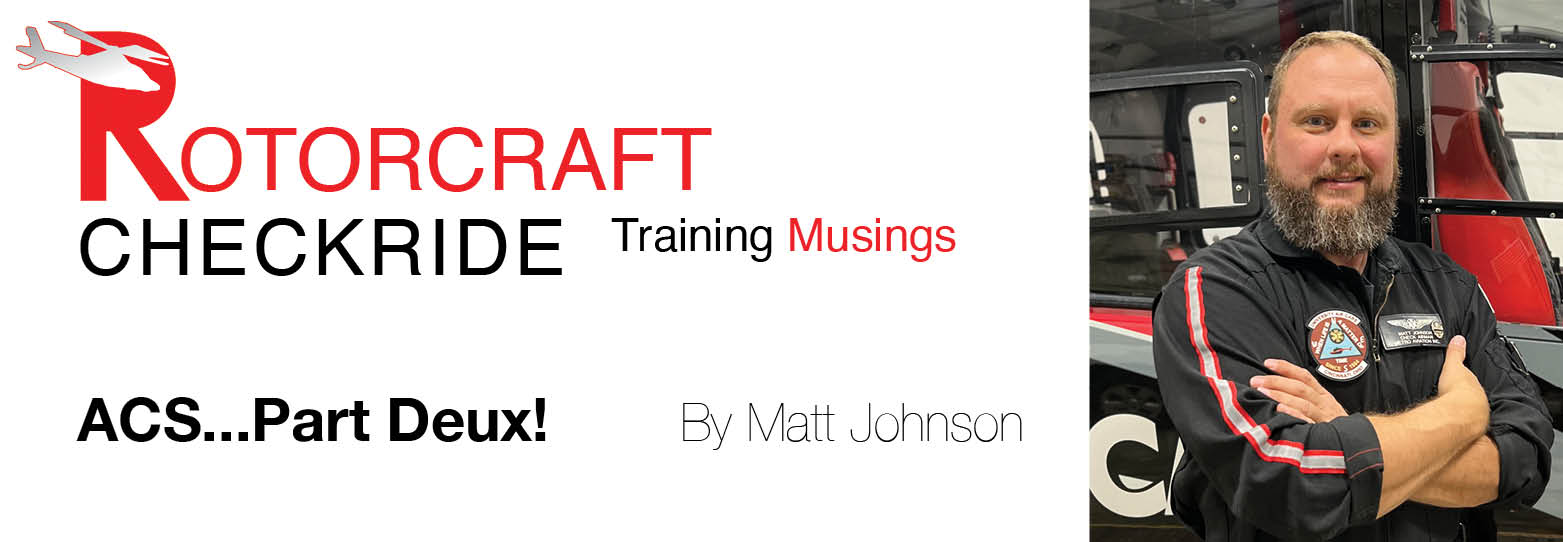|
Aug
29
2024
|
|
Posted 1 years 123 days ago ago by Admin
|
|

Yes, I’m dropping a little French on you. For the first time since I took over this column nearly two years ago, I am writing a “Part Two” to follow up on my last issue’s column. I feel this topic is that important.
The new Airman Certification Standards took effect on 31 May 2024. From my observations, there haven't been many "hiccups," but I can only assume that, like me, my fellow DPE colleagues across the country have received a lot of questions on ACS particulars. A perfunctory glance at the new ACS just won't cut it. Hence the reason for this Part Two.
My last piece was an introduction to the ACS. In this piece, I’ll go more in-depth and discuss some, but obviously there’s not enough space for all changes. First up, let’s look at a couple of airspeed changes, including changes to the autorotation speed tolerance (more on that soon). For the maximum performance takeoff and climb task, the standard now specifies "transition to normal climb attitude, airspeed +/- 5 knots" for both the Private and Commercial tasks. The previous PTS listed the tolerance at +/-10 knots for the Private and +/-5 for the Commercial standard.
For the straight-in autorotation, autorotation with turns, and powerplant failure at altitude, the new Private ACS now allows a +/-10 knot tolerance whereas the previous Private PTS listed the standard at +/- 5 knots. The autorotation tolerance for the Commercial ACS remains at +/-5 knots. While speaking of autorotations, you should read this section thoroughly in the new ACS. Under both the straight-in and autorotation with turns, you will find that the ACS—under the notes section—will direct you to "see Appendix 2: Safety of Flight and Appendix 3: Aircraft, Equipment and Operational Requirements & Limitations for information related to this task.” Focusing on Appendix 3 alone, we find verbiage that states: "The minimum entry altitude must be at least 500 feet AGL or a suitable higher entry altitude in strong wind conditions"(for straight-in Autorotations). This section also states that: "Initiating a go-around as a result of an applicant's inability to complete this Task within the tolerances specified in the skill elements is considered unsatisfactory." So, being off on the selected spot and doing a go-around isn't going to cut it. Looking at the autorotation with turns task, Appendix 3 reads:
"The minimum entry altitude must be above 700 feet AGL or a suitable higher entry altitude in strong wind conditions. At least two 90 degree turns in the same direction or one continuous 180-degree turn must be performed. The 180-degree turn refers to a change in direction with respect to ground track, and not an exact reciprocal heading. If the applicant does not roll out of the turn by 300 feet AGL then the evaluator must direct the applicant to perform a power recovery and initiate a go-around, and the Task is considered unsatisfactory"
Indeed, there’s a lot to digest here. For one, the minimum altitudes specified for both the straight-in and autorotation with turns are just that— a minimum.
Another topic of interest is about the new requirements in the Commercial ACS for Flight Solely by Reference to Instruments and Recovery from Unusual Flight Attitudes. The common question surrounds itself with what instrumentation is required. For this answer, direct your attention to “Appendix 3: Aircraft, Equipment, and Operational Requirements & Limitations.” Here, we find a statement under the "Equipment Requirements & Limitations" header that reads: "The aircraft must meet the requirements as outlined in 14 CFR part 61, section 61.45". This information was confirmed in a good briefing that was uploaded on YouTube by the FAA GA and Commercial Division, Testing Standards Section in May 2024. Essentially, the helicopter must be instrument-equipped, but is not required to be certified for instrument flight. It is essential also to note that guidance also clarifies that a helicopter only capable of a partial panel is not acceptable for flight solely by reference to instruments and recovery from unusual flight attitude tasks.
Also for Instrument and ATP folks, previous versions of the Instrument and ATP ACS and PTS described the 300 foot height above touchdown (HAT) on an LPV line of minima, as the dividing factor between a Precision and Non-Precision Operation. In the new version of the ACS and PTS, the 300 feet HAT was removed. Any RNAV (GPS) LNAV/VNAV or LPV line-of-minima approach to a Decision Altitude is considered a Precision Approach Operation for Training and Testing.
The ACS deserves your undivided attention. Like anything, it will take time to settle into this new way. I still like what I see and what I’ve experienced with the ACS thus far. I am optimistic that it will only improve with future updates.
YouTube Channel: https://www.youtube.com/channel/UCt4y..
READ MORE ROTOR PRO: https://justhelicopters.com/Magazine
WATCH ROTOR PRO YOUTUBE CHANNEL: https://buff.ly/3Md0T3y
You can also find us on
Instagram - https://www.instagram.com/rotorpro1
Facebook - https://www.facebook.com/rotorpro1
Twitter - https://twitter.com/justhelicopters
LinkedIn - https://www.linkedin.com/company/rotorpro1